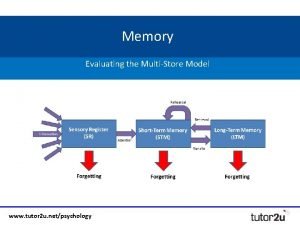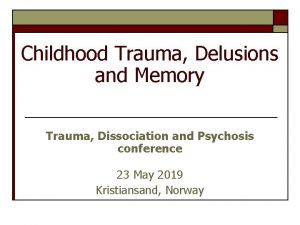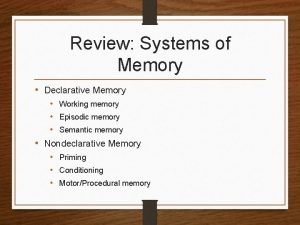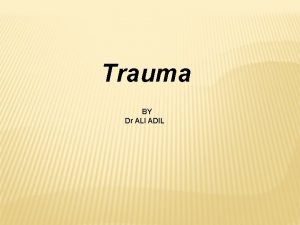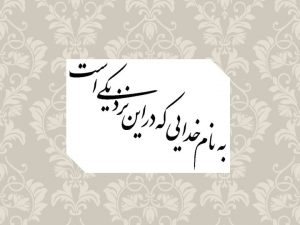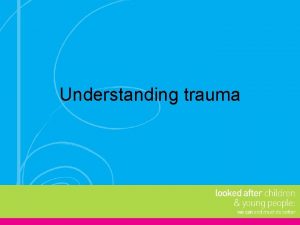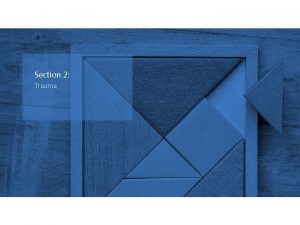TRAUMA AND MEMORY Outline Review Trauma from Experience








![Issues (3): Truth Claims; Transhistorical and Historical Trauma • “When absence [or lack] is Issues (3): Truth Claims; Transhistorical and Historical Trauma • “When absence [or lack] is](https://slidetodoc.com/presentation_image/575680efe362ad1a84db0dd9be975d13/image-9.jpg)









- Slides: 18

TRAUMA AND MEMORY

Outline

Review -- Trauma: from Experience to History • Experience not assimilated, experienced belatedly: • “not assimilated or experienced fully at the time, but only belatedly, in its repeated possession of the one who experiences it. To be traumatized is precisely to be possessed by an image or event” (Caruth 1995: 4 -5). • Crisis in History or Truth: • If PTSD must be understood as a pathological symptom, then it is not so much a symptom of the unconscious, as it is a symptom of history. The traumatized, we might say, carry an impossible history within them, or they become themselves the symptom of a history that thy cannot entirely possess. (Caruth 1995: 5)

Issues • How do the traumatized experience and understand their trauma? (e. g. Didion’s mourning and melancholia, rationalization, rational control of herself and magical thinking) • How do we understand/witness trauma, or a traumatic event, as by-standers or simply outsiders? (e. g. mediation -- Hiroshima mon amour -- traumatic memories triggered by bodily/verbal connection with another person with another trauma; testimony as an inter-subjective process; transmissibility of trauma inaccessibility/Otherness of others’ trauma (despite its visibility) [avoiding over-identification with, appropriation of, others trauma]

Issues (2): repetition • Revisiting the past compulsively; • The haunting of an unresolved past history/memory; • Traumatic memories • Narrated memories Repetitions in “acting out” and “working through” “Traumatic memory is inflexible and replays the past in a mode of exact repetition, while narrative memory is capable of improvising on the past so that the account of an event varies from telling to telling” (87).

“Acting out” vs. “Working through” • Applies to both survivor and secondary witness (or historian) • Acting out-- ''undecidability and unregulated différance [of the middle voice] threatening to disarticulate relations, confuse self and other, and collapse all distinctions, including that between present and past, are related to transference and prevail in trauma and in post-traumatic acting out in which one is haunted or possessed by the past and performatively caught up in the compulsive repetition of traumatic scenes… (La. Capra 21) • Working through – “one is able to distinguish between past and present and to recall in memory that something happened to one (or one’s people) back then while realizing that one is living here and now with openings to the future. (22)

“Acting out” vs. “Working through” (2) • This does not imply either • that there is a pure opposition between the past and the present or that • Acting out…can be fully transcended toward a state of closure or full ego identity. But it does mean that the processes of working through may counteract the force of acting out and the repetition compulsion. Working through-When the past becomes accessible to recall in memory, and when language functions to provide some measure of conscious control, critical distance and perspective, one has begun the arduous of working over and through the trauma…(90)

Issues (3): Truth Claims; Transhistorical and Historical Trauma • The functions of documentary in Obasan. • the loss is of a specific object caused by, or causing, a historical or individual trauma, vs. absence (together with its narrativized forms, such as loss of innocence, full community and unity with the mother), which is more fundamental and “transhistorical” (or structural), signaling the absence “of/at” the origin that appears in different ways in all societies and all lives (Writing History 77).
![Issues 3 Truth Claims Transhistorical and Historical Trauma When absence or lack is Issues (3): Truth Claims; Transhistorical and Historical Trauma • “When absence [or lack] is](https://slidetodoc.com/presentation_image/575680efe362ad1a84db0dd9be975d13/image-9.jpg)
Issues (3): Truth Claims; Transhistorical and Historical Trauma • “When absence [or lack] is converted into loss, one increases the likelihood of misplaced nostalgia or utopian politics in quest of a new totality or fully unified community. When loss is converted into …absence, one faces the impasse of endless melancholy, impossible mourning, and interminable aporia in which any process of working through the past and its historical losses is foreclosed or prematurely aborted” (La. Capra 46).

Issues (4): 2 nd Generation’s Re-construction of Trauma • Postmemory and Photo-memory

POSTMEMORY Past Lives, 1987 (Image source), LORIE NOVAK

Note on the Photograph 1. The children of Izieu- the Jewish children hidden in a French orphanage in Izieu who were eventually found and deported by Klaus Barbie. 2. Ethel Rosenberg's face-- a mother of two young sons, was convicted of atomic espionage and executed by electrocution together with her husband Julius Rosenberg. 3. In the background of Novak's composite image is a photograph of a smiling woman holding a little girl who clutches her mother's dress and seems about to burst into tears. This is the photographer Lorie Novak as a young child held by her mother. Novak was born in 1954 and thus this image dates from the mid-1950 s. (Hirsch 5 -6)

Interpretation of the Photograph • “If it is a drama of childhood fear and the inability to trust, about the desires and disappointments of mother-child relationships, then it is also, clearly, a drama about the • power of public history to crowd out personal story, about the shock of the knowledge of thís history: the Holocaust and the cold war, state power and individual powerlessness” (Hirsch 6) • It reveals memory to be an act in the present on the part of the subject who constitutes herself by means of a series of identifications. . . It reveals memory to be cultural, fantasy to be social and political. • The second-generation memory of Holocaust

Post-Memory • Postmemory is a powerful form of memory precisely because its connection to its object or source is mediated not through recollection but through projection, investment, • and creation. This is not to say that survivors’ memory itself is not mediated but it is more directly connected to the past. • Postmemory characterizes the experience of those who grew up dominated by narratives that preceded their birth …(8)

Post-Memory(2) –Lines of Relations • It is a question of adopting the traumatic experience of others as one’s own life history. It is a question of conceiving oneself as multiply connected with others of the same, of previous, and of subsequent generations, of the same and of other-proximate or distant -cultures and subcultures. It is a question, more specifically, of an ethícal relation to the oppressed or persecuted other for which postmemory can serve as a model: as I can “remember“ my parents' memories, I can also “remember" the suffering of others, of the boy who lived in the same town in the ghetto while I was vacationing, of the children who were my age and who were deported. (Hirsch 9)

Post-Memory(2) –Lines of Relations -Issues • -- Can identification “resist appropriation and incorporation, resist annihilating the distance between self and other, the otherness of the other” (Hirsch 9) ? • -- heteropathic identification (identification at a distance) in which the self and the other are more closely connected through familial or group relations. • -- e. g. Camera images: past received in present tense • e. g. “Past Lives? ”

Identification but not Over-Identification • The challenge for the postmemorial artist is precisely to find the balance that allows the spectator to enter the image, to imagine the disaster, but that disallows an overappropriative identification that makes the distances disappear, creating too available, too easy an access to this particular past. (H 10)

Works Cited • Caruth, Cathy. “Introduction, ” in Caruth, ed. , Trauma: Explorations in Memory. John Hopkins UP: 1995 3 -12. • Hirsch, Marianne. “Projected Memory: Holocaust Photographs in Personal and Public Fantasy. ” Acts of Memory. Eds. Mieke Bal, Jonathan Crewe, Leo Spitzer. Hanover: UP of New England, 1999: 3 -23. • Whitehead, Anne. Trauma Fiction. Edinburgh: Edinburgh UP, 2004.
 What is indirect experience
What is indirect experience Experience expectant vs experience dependent
Experience expectant vs experience dependent Continuity vs discontinuity
Continuity vs discontinuity Internal memory and external memory
Internal memory and external memory Primary memory and secondary memory
Primary memory and secondary memory Virtual memory and cache memory
Virtual memory and cache memory Outline and evaluate the multi-store model of memory
Outline and evaluate the multi-store model of memory Bread sentence
Bread sentence Semantic memory example
Semantic memory example Implicit memory vs explicit memory
Implicit memory vs explicit memory Long term memory vs short term memory
Long term memory vs short term memory Logical memory vs physical memory
Logical memory vs physical memory Which memory is the actual working memory?
Which memory is the actual working memory? Virtual memory in memory hierarchy consists of
Virtual memory in memory hierarchy consists of Eidetic memory vs iconic memory
Eidetic memory vs iconic memory Shared vs distributed memory
Shared vs distributed memory Chapter review motion part a vocabulary review answer key
Chapter review motion part a vocabulary review answer key Ap gov review final exam review
Ap gov review final exam review Nader amin-salehi
Nader amin-salehi






